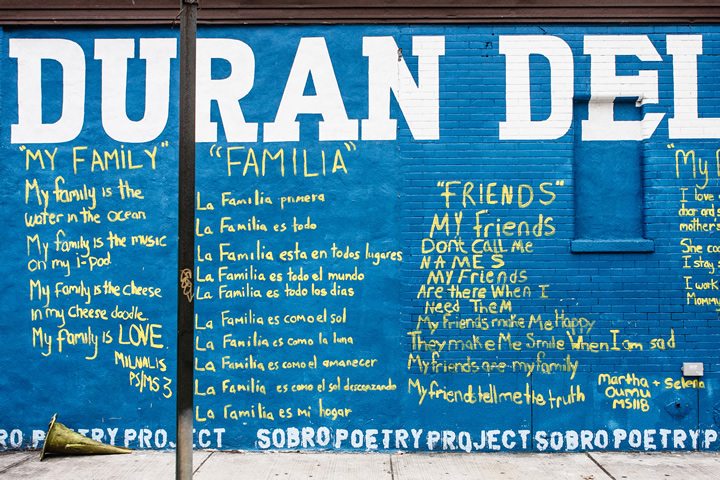 Blogging: A Surprising Way to Practice Your English in New York City
February 27, 2017
Blogging: A Surprising Way to Practice Your English in New York City
February 27, 2017
You might have noticed how easy it is these days to get your words out into the public—with the Internet, our smartphones, and social media, we’ve never had it easier to be heard. You also might agree with me that one of the most comforting things in the world when you’re going through a huge transition is to find out that you’re not the only one and that you’re not alone. You now have the opportunity to share your experiences with one another, offer each other advice and learned lessons, and ultimately discover a new confidant.

Getting Started
It might be scary at first to think about sharing such vulnerable experiences with the world, so I recommend to first write out an entry about perhaps your day, your first impressions upon coming to New York City, or even questions you have about the people, the culture, or the city itself. There are several platforms that allow your entries to be either private or public, so this way, you don’t have to expose yourself if you feel it’s too soon. You’ll also get a feel for how often you see yourself posting, how personal you want to get, and how big of a project you forsee this becoming.
The great thing about this method is that you’ll get practice WRITING your English instead of just communicating it verbally. You’ll learn a lot about your English skills if you find yourself using your dictionary or your translator a lot or if it comes to you pretty naturally. As you’re writing, you might also realize that this is the perfect time to test out new and foreign slang or idioms that you would otherwise be too nervous to try out in person. You have the chance to look them up before committing to them, and the more practice you get with putting them to use, the braver you’ll be to use them in person!
Finding your thoughts
Another great thing about blogging is that it forces you to reflect. Before I started my own blog, I was very apprehensive because it felt like I was on display, and I was nervous about that. But I sat down and just started typing my thoughts and feelings without too much worry or concern about grammar (I looked at that later), and I realized that I had quite a bit going on in my head! Once I cleaned up the “entry” and felt like it was polished, I published the piece. I obviously didn’t have a huge following at the time, but when I was sharing some of my worries or concerns, the community that I DID have was so supportive and encouraging. They offered advice, shared similar stories, and cheered me on to keep going. It was just enough to convince me to keep writing.
Finding your followers
Once you find a blogging platform that you like and you establish your profile, spend some time on Facebook and look for groups that are new to both the English language as well as New York City. Join as many groups as you can and post a link to your new, live blog (I’d make sure you have at least one post live at this point so that they can get a taste of who you are), and include a short introduction about yourself and invite others to take a journey into your experience. You might find that a lot of people will come to your page to hear about your stories to see if they’re similar to their own, and you will, without a doubt, develop a circle of support and encouragement. Furthermore, you will have the opportunity to learn from your new followers as well as they share their own funny stories or mistakes they’ve made along the way.
Finding your reach
Again, one of the greatest parts of living in this generation is our constant connection to everything and everyone at any time. You could reach people not just in New York City, but you could develop a network of ANY newcomers to the United States as they adjust to the English language and American culture. Additionally, you also might find that you might reach English speakers that are studying abroad in other countries beyond US borders as they’re facing the exact same hurdles! While the experience is the exact opposite, the emotions and fears behind starting a life in brand new world with a different language are universal.
 How to Budget in NYC While You Learn English
February 20, 2017
How to Budget in NYC While You Learn English
February 20, 2017
Before I moved to New York City, so many people warned me about the cost of living and expressed their concerns about money and whether or not I’d “make it work.” Of course I was concerned about this myself, but I was determined to make sure I could do it and afford to live in New York City—and STILL have a life!
I’ve come up with some tips and tricks to make sure living in the big city is practical and achievable so that you can afford all your monthly bills and still have some left over to enjoy yourself and take in all that New York City has to offer!
1. Map out your monthly budget
Add up all of your monthly expenses, including rent, utilities, cell phone, memberships, groceries, student loans, and any other monthly payments you are obligated to make. From there, you should be able to figure out how much you have left over for additional spending per month. This will also give you an idea of how much flexibility you have for social activities. Once you have a rough figure in mind, spend some time on the Internet for activities you can do that will help you enhance your English skills. Maybe find an off-Broadway show that offers cheap tickets on Sunday afternoons; read the plot in English before you visit the show so you can appreciate the acting and singing more since you already know the storyline. Bonus: reading the plot in English then watching it in English will cement your language fluidity for sure!
2. Never pass up free!
Keep an eye out in your neighborhood for new businesses opening—usually within their first week’s opening, they’ll invite the community to try out samples, hand out free goodies, or offer complimentary services to generate new customers. If you’re feeling brave and looking to save a few bucks, visit a beauty school for a haircut—they will either offer free or massively discounted services to allow their students to practice on real human heads! And of course, there are endless museums in the city that offer free admission—and that’s priceless for a taste of New York City culture! Interacting will all these divisions in the city will definitely enhance your English speaking and learning skills, and before you know it, you’ll be having casual conversations with your new hairdresser or neighbor without even realizing you’re speaking in fluent English!
3. Just say no
If you say no to just a few things each month, you might notice that you’re tucking away money bit by bit each month. It can be so easy to drop $12 here for lunch or $16 there for a cab ride; but as they all say, all those little expenses add up very quickly, and by the end of the month, you could be looking at your bank statement wondering, “Where did all my money go?” I found that if I’m invited out to a happy hour for a birthday celebration, and I know I should be keeping an eye on my finances, I’ll accept the invitation but instead stick to drinking water (free!)—this way I won’t be spending my money, AND I won’t miss out on the social experience! It might be a bummer at first to turn down a lot of experiences that others may participate in, but ultimately I guarantee you’ll feel better about your finances, and you won’t experience what I call “spender’s guilt.” Plus, it’s definitely easier to practice your English when you’re sober!
4. Check out discount stores
At first I felt embarrassed about shopping at Goodwill stores or dollar stores, but ultimately, my wallet thanks me. If you have the time and the patience to sift through the clothing racks at Goodwill or second-hand stores, I say go for it. Almost all of my work wardrobe is from these stores, and I get compliments on my clothing all the time—when people ask me where I got my top, I proudly announce, “the Goodwill store on 88th and 2nd.” Their reaction is priceless, and I walk away knowing that I paid $3 for my blouse while my coworker spent $40 on hers. I buy my shampoo and toothpaste at the dollar store because no one will be able to tell how much I spent just from my hair. Cheaper doesn’t always necessarily mean worse, and more expensive doesn’t necessarily mean better.

 Food, English, and New York City—Learning the Balance
February 13, 2017
Food, English, and New York City—Learning the Balance
February 13, 2017
One of the absolute BEST things about New York City is the abundance and variety of food. You can get all sorts of cultural cuisine just in the radius of one block—I can guarantee you’ll never be bored with your options! The tricky thing is that very few people can afford to eat out or order delivery every day, so I’ve come up with a few helpful options for you that will help you sort out your dining budget without sacrificing the rich culinary culture in the Big Apple.
1. Purchase your kitchen staples
Before you even explore restaurants and trendy, cultural neighborhoods for new and exciting food, make a list of your favorite basic at-home foods. For me, cold cereal and pasta are my go-to meals when I’m at home. These are easy to make, fairly cheap, and I’m always in the mood for these items if I’m hungry but too lazy or broke to explore other options. With this in mind, I make it a point to ensure I always have these ingredients at home. Try and make your own list of kitchen “must haves” without using your English dictionary, then head to your closest grocery store or bodega and pick up these staple items. You’ll already feel one step ahead of the game once you have some basics in your kitchen. Knowing that you have “rainy day” ingredients will be enough to convince you to stay in more often and eat at home.
2. Next, pick up your luxury items
Once you have the above basics in your cupboards, make another list of items that you might consider “luxury items” from the grocery store. For me, these are things that I don’t necessarily need, but things that I would want on a special occasion. For example, apples are my favorite fruit, but when they’re not in season, they can be a bit pricey. So I’ll add these to my luxury list. I know I don’t need them, but I also know that if I have them at home, I’ll eat each and every single one! Again, this will deter me from spending my precious money on steep delivery fees when I’m tempted to order take-out. Again, try making this list without referring to your dictionary; then when you hit the grocery store or the bodega, trust your own list, find the aisles without your apps, and see what happens! Even if you buy something incorrectly or purchase something that wasn’t on your list, you’ll have something new and different to try out!
3. Now make the FUN list!
Now that your kitchen is fully stocked with your dream pantry, you can figure how much money you have left over to try food beyond the grocery store limits. Maybe you’re dying to head to Little Italy to see what great cuisines they have to offer, or maybe you’re fiending for some Polish food, so you make a list of great places to try in Queens. Making these lists will help you come up with a game plan for travel, spending, and limits. The great thing about technology these days is that apps like Yelp provide reviews of these eateries, and most locations have their menus online. Again, this can help you pick out what you want before you arrive—this way, you’ll already know the components in each dish, how much it costs, and what other people have thought about the dishes and the experience. Plus, by having this plan of attack beforehand, you can practice your English vocabulary for both food-related words as well as conversational pieces with your fellow diners as well as your waiter or waitress. There’s no better way to put your English practice to use than real world application!
If you plan these purchases in advance, both with groceries and dining out, it can be close to impossible to experience any spending surprises. Of course, there will be meal spending that is almost unavoidable, like perhaps a friend’s birthday dinner, or maybe a snowstorm delayed your grocery shopping plans for a few days, so takeout is the most practical option. But in my experience, if you put your food spending on a practical plan like this one, you’ll avoid spending too much on food yet still allow yourself the cultural culinary experience that makes New York City such a wonderful place to be.

 Finding the Right Place to Live in NYC While You’re Learning English
February 6, 2017
Finding the Right Place to Live in NYC While You’re Learning English
February 6, 2017
Manhattan is only 13.4 miles from top to bottom and 2.3 miles from east to west. When you stop and think about it in this way, you realize just how small the borough really is! With that, you have to wonder where all the 1.6 million people that live in Manhattan actually live. How can such a tiny place hold so many people?
It can be daunting to find a place to live in New York City with this in mind, especially if learning English is on your long list of daily goals. The renting market is quite competitive, as there are hundreds of people looking for places to live, whether they’re new to the city, here temporarily, or looking to simply switch neighborhoods or try a different scene. The advantage to this is there is never a shortage of great units to choose from!
Before going on your search, I recommend spending some time alone with your online bank account and take record of your overall budget. Make a list of every obligatory bill you have to pay each month: this must include any and all credit card bills, student loans, health insurance payments, monthly memberships (gym, Apple, etc.), cell phone payments, and any other establishments that require payment on a monthly basis. From here, figure out how much you have to spend on rent per month. This will give you an idea of how comfortable you’d like to live: are you okay with spending a bit more on a nice apartment but sacrificing many social activities, or would you rather pay less in rent for a small unit far from the subway in order to have more social spending money? Once you address these questions, you’ll have an idea of approximately the price range of your ideal apartment.
From here, this is where you’ll put your English learning skills to use. Before beginning your search, make a list of questions you envision asking the landlord and/or potential roommates. I’d recommend writing them down—in English!—because it can be very easy to go blank and completely forget what you want to ask. Inquire about safety of the neighborhood, walking distance to public transportation, grocery stores, laundry facilities, etc., and don’t forget to ask about general apartment questions, such as average utility bills per month, noise levels, and roommate habits/behaviors. The more you think to ask in the beginning, the less surprise there will be later if you decide to take the apartment! Writing down these questions in English will help the flow of your conversation, and engaging with these individuals will make you feel more comfortable with the language overall.
Now you are ready for the search! There are two sites that I highly recommend that will help you learn about the different boroughs and neighborhoods.
1. CraigsList
This is a great site to help you learn and adjust to city living. You can search for housing by location, price range, if you’re looking for a place of your own or looking to rent a room, or if you’re even just looking for something temporary. If you’re tight on money, you might start to notice that there are certain neighborhoods that support your budget—make sure you then research the neighborhood so you learn whether you can envision yourself living there. Map out your commute, figure out where the closest grocery store would be, etc—doing this will give you an idea of life in that apartment.
2. SpareRoom.com
This is also a great resource for those looking to split the cost of housing by renting out just a bedroom. Again, you can search by price, neighborhood, size of bedroom, whether the room is furnished or not, and on and on. You’ll quickly learn that you have many options when it comes to New York City living, and you can get really creative when it comes to finding a place to call home.
Of course, with every situation, make sure you meet these people in a public setting first and tell people what you’re up to while you’re looking at the apartment; you can never be too careful! Again, before looking at the unit, make a list of questions in English so that you don’t forget to ask anything—practice asking them and practice some example follow-up questions. Don’t be afraid to ask for clarification or personal opinions—everyone else was new here once, too!

Recent entries
- Handling Current Event Stress While Taking Care of Yourself
- New York City This April – How to Stay Entertained While Putting Your English Skills to Use
- The Best Tools that Education Organizations Use to Improve Productivity
- March in New York City – Staying Entertained While Working on Your English
- Navigating an Ongoing Pandemic in New York City
Category
Archive
- April 2022
- March 2022
- February 2022
- January 2022
- December 2021
- November 2021
- October 2021
- September 2021
- August 2021
- July 2021
- June 2021
- May 2021
- April 2021
- March 2021
- February 2021
- January 2021
- December 2020
- November 2020
- October 2020
- September 2020
- August 2020
- July 2020
- June 2020
- May 2020
- April 2020
- March 2020
- February 2020
- January 2020
- December 2019
- November 2019
- October 2019
- September 2019
- August 2019
- July 2019
- June 2019
- May 2019
- April 2019
- March 2019
- February 2019
- January 2019
- December 2018
- November 2018
- October 2018
- September 2018
- August 2018
- July 2018
- June 2018
- May 2018
- April 2018
- March 2018
- February 2018
- January 2018
- December 2017
- November 2017
- October 2017
- September 2017
- August 2017
- July 2017
- June 2017
- April 2017
- March 2017
- February 2017
- January 2017
- December 2016





